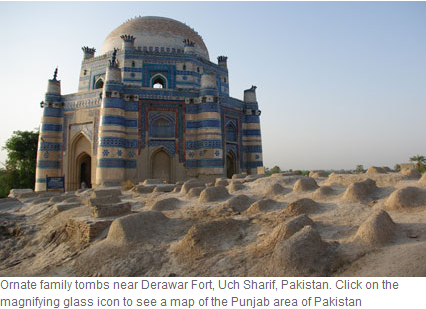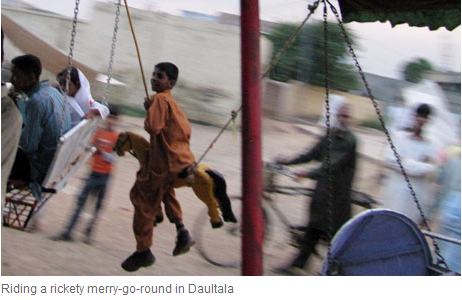Saints and singers in Pakistan's Punjab
A new tour of Pakistan's Punjab province offers mystical culture, amazing food and friendly homestays

"Come to Islam," says 16-year-old Mohammed Irfan, as I enter the courtyard of the exquisite blue-tiled Eidgah mosque in Multan, a hot, dusty town in Pakistan's Punjab province, known – or rather, barely known – as the City of Saints.
"I come here and pray for wealth, a long life, so that we're able to eat, and for good results in school. I've been coming for a long time, and as a result, I've come first in my class in my exams," he beams, his smile as dazzling as the mirror mosaics that adorn the shrine to Sufi saint Ahmad Saeed Kazmi, a scholar and spiritual teacher.
Sufism is the mystical arm of Islam, and the Punjab is the Sufi heartland of Pakistan. The scene of centuries of cultural invasions, it's also the country's wealthiest and greenest province (despite the blistering expanses of the Cholistan desert, on its south-eastern edge), stretches from Sindh province in the south to the foothills of the Himalayas in the north, and is home to more than half of Pakistan's population.
Alas, the few tourists who make it here usually shoot up the Karakoram Highway to the rugged, frontier northern districts. Understandably so, as Pakistan's mountains are unendingly beautiful, but the Punjab, with its Mughal and pre-Mughal architecture, jewel-like shrines and mosques, desert dunes and farmland, and ancient towns and cities, begs to be explored, too.
Which is how I come to travel five hours south from Lahore to the 4,000-year-old city of Multan. It's a traffic warden's nightmare, with mopeds, autorickshaws and donkey carts doing battle on the streets. I'm with a small group, led by Sohail Azhar, the British-Pakistani founder of London-based tour operator TravelPak, chatting to a group of schoolboys in the mosque. They, like everyone I meet in the Punjab, are balm to the soul: warm-hearted, jolly, and politely curious about the visitors in their midst.
The Eidgah mosque aside, Multan has its share of must-see monuments, (including the stunning mausoleum of Sufi saint Shah Rukn-e-Alam, and the lovely, if unimaginatively titled, Institute of Blue Pottery Development – great for watching the artists at work, and buying gifts ) but it is also our base for an excursion to the small town of Uch Sharif.
Once controlled by Alexander the Great, and one of the oldest centres of learning in Pakistan (the name means "holy high place"), the town is about three hours' drive to the south of Multan. It's on the edge of the Cholistan desert, a vast, thorny acacia-dotted landscape, with nomadic herders leading camels and goats to water holes. The bastions of the derelict Derawar Fort are visible for miles. Every year in February and March, pilgrims flock to this part of the desert to pay their respects at the shrine of the "sand dune saint", Channan Pir, a child abandoned in the desert, according to legend.
As I climb the steps to Uch's exquisite blue-tiled shrine to the (tongue-twisting) saint Jalaluddin Surkh-posh Bukhari, I'm intercepted by a stocky fellow in a red hat, who places his hand on my forehead and mutters a few words, before shuffling away. Have I been blessed by a Pir, a Sufi religious leader-cum-faith healer?
"Genuine Pirs are thought to have inherited their spiritual powers," Sohail had said on the way here. "People consult them on anything from religious matters to medical problems like infertility – or even family relationships." Sadly, my benediction is a false one: a small boy sidles up, points to the man in the hat, and makes a "crazy" sign.
I pass a handful of devotees in the courtyard and at the entrance to the darkened shrine, a guardian leads me to the saint's tomb, which is wreathed in velvet drapes. My head is placed under the fabric, and muffled blessings for health, wealth and prosperity wash over me. It's a long, disorienting moment, but also a comforting one.
There are more poetic incantations later that night, when we walk over to the mausoleum of Baha-ud-Din Zakaia to listen to a Qawwali singer. Qawwalis, or devotional songs, are at the heart of Sufi religious practice – the aim of the music is to lead listeners into a state of spiritual ecstasy. There is certainly a mystical quality to it, and the complex is thick with incense, candles and the shapes of followers quietly padding about barefoot.
"The poet Rumi likened a Qawwali to listening to the divine creaking of the gates of heaven," says Sohail.
Later we enjoy sustenance of a different nature, in the village of Daultala, four hours north-west of Lahore, when Sohail whisks us off to the home his late father had built shortly before his retirement. Expecting modest quarters, I'm taken aback when we reach a three-storey compound, behind high gates and surrounded by meadows.
Within, I count 10 bedrooms, most with en suite bathrooms. The welcoming committee – Sohail's aunt, Hala, lives here, as do various cousins, nieces and other members of his extended family – is as large as it is gracious. Within minutes of arriving there's a home-cooked meal on the table: lamb curry, rice, patties made from meat and chickpeas, a kind of raita with vegetables, chapatis and rice pudding. It's utterly delicious, and my attempt to express my thanks, shukriya in Urdu, feels woefully inadequate.

"Are you married?" 23-year-old Huma, the glossy-haired wife of one of Sohail's cousins, wants to know. It's a question I'm asked over and over in Pakistan. And the reaction to my response – an embarrassed shake of the head (I'm no spring chicken) – is always the deepest, sweetest sympathy.
After dinner, I head up to the roof and, in the fading light, survey a pastoral scene that would be timeless – blossoming flowers, fragrant air, kids playing cricket in the fields, flat-roofed and pastel-coloured houses, the silhouettes of villagers bent over their crops – were it not for the rather incongruous sight of a ferris wheel in the distance. Yes, the funfair has come to Daultala, and we are going.
Butterflies and passersby flit around us as we stroll along the country lanes. Foreigners are a rarity and special fascination is reserved for Ryan, the young American in our group. "Now I know how Madonna feels," he quips.
The funfair rides would make a health and safety officer shudder – they're rickety, rusty and divinely antiquated. Still, the merry-go-round doesn't collapse under my weight, and how often does one get to ride one surrounded by a mesmerised 20-deep crowd of grown men?
Later, we weave past colourful food and fabric stalls to the gurdwara, or Sikh temple. It's a crumbling ruin – the Sikhs left after Partition in 1947, explains Sohail, and the gurdwara was used as a school until it was damaged in the 2005 Kashmir earthquake – but my torch illuminates stone pillars, balconies and delicate lattice-work.
The walk back to the village in the cool of the evening feels like a strange dream. One of Sohail's nieces takes my hand and begins to sing. The tune sounds familiar: it's Celine Dion's My Heart Will Go On. Not in Urdu though. Or English. But Mandarin Chinese. "I learnt it at school," she says casually. I'm startled, but perhaps ought not to be – the friendship between the two countries is an enduring one.
We wind up our Punjab tour in the city of Lahore, the cultural and artistic mecca of Pakistan. A former Mughal capital, it's home to the sublime Badshahi Mosque, its creamy marble domes and sandstone minarets much more than the sum of its parts. Opposite it, and adjacent to the walled Old City, is the Lahore Fort, containing a maze of gardens, halls and palaces. My favourite, the Palace of Mirrors, filled with glittering, multicoloured mosaics, was built by Emperor Shah Jahan in 1632 for his wife, Mumtaz Mahal. It's not known whether she saw it before she died in childbirth – and her grief-stricken husband had the Taj Mahal built in her honour.

The best views of the mosque and fort – all soft and rose-tinted at sunset – are from the roof of Cooco's Den, a restaurant in the Heera Mandi, or red-light district, in the Old City. It's a stylish, if kitsch, restored haveli (mansion) and the owner, Iqbal Hussain, is a painter. His pictures of Lahore's voluptuous Nautch dancers – descendants of the city's fabled royal courtesans – adorn the walls. The home-style Pakistani fare, heavy on grills and kebabs, and once sampled by the likes of cricketer-turned-politician Imran Khan, isn't bad either.
One night, we check out Lollywood, Pakistan's answer to Tinseltown. A few weeks before, outside a mosque in Chitral, up in the mountains, I'd bumped into a film producer/actor (or "Hero", as leading men here like to be known). On hearing that we'd be in Lahore, he'd invited us to a shoot.
I'm not sure what we'd been expecting: lashings of glamour – and perhaps a contraband mini-skirt or two – however, but the forlorn complex in a back lot that our driver Rachid, nearly cannot find is anything but. Shan, our minder and as luvvy as they come, tells us that Shahid Khan, a star of Pashto-language films, is on set right now. When the cameras whirr, neither he nor his leading lady can deliver more than two words of dialogue, before the director screams "cut". Stifling our giggles, we leave them to it.
The next night Javed, a guide, English teacher and friend of Sohail, takes me to his home he shares with his wife and children, in the red-light district. We wander down narrow streets, ablaze with neon. There are vendors hawking savoury fried snacks, sweets and paan, dozens of dhabas (informal food joints).
The Phajja Paye restaurant is famous for its sticky goats' trotters, although tongue, brain and jawbone are also on the menu. "It's the best known restaurant in all of Lahore,'' says Javed. "Men are drawn here like bees to honey." It's not just for the food. The air is thick with anticipation, but the ladies of the night, so vividly rendered in Cooco's Den, won't be putting in an appearance until the wee hours of the morning, he tells me.
We veer off sharply, down an alley that is momentarily plunged into darkness, thanks to nightly electricity shortages. Javed flicks on his lighter, and I follow him through a narrow entrance and up a cramped staircase, into the tiny, immaculate flat. Waiting to greet us are his wife, Selma, and three young children. I'm ushered into the living room, which also doubles as the bedroom.
After a little chit-chat, Selma produces a dinner of barbecued chicken, even though I've only come for tea, and the household has eaten. The family watch me tuck in, and when I've finished licking my fingers, Javed, who is also a poet, reads from his work.
It's an exalted moment – the flickering flame, the haunting verse. I don't need Qawwalis or Sufi holy men to experience a communion with the divine – it is right here, around the hearth of a warm and open-hearted Lahori family.
The trip was provided by TravelPak (08445 558855, travelpak.co.uk). The firm runs two tours which feature the Punjab – Pakistan's Cities: 5,000 Years of History and Culture (13 days, from £1,445 excluding flights) and Pakistan's Archaeology and Sufi Shrines (14 days, from £1,495, excluding flights). Both tours run October–May.
International flights were provided by Oman Air (08444 822309, omanair.com) which flies from Heathrow to Lahore from £625 return